Animals are most likely to be exposed to the reproductive part of fungus (the fruit body, a mushroom or toadstool) that is visible; the vegetative part of the fungus (the mycelium) is hidden within the substrate the fungus is growing on, e.g. in soil, tree bark, etc (Figure 1). There are many, many species of larger fungi and these fruit bodies are variable in shape, colour and size and these characteristics can change during development and later deterioration. The terms ‘mushroom’ and ‘toadstool’ are interchangeable and not helpful in deciding whether a fruit body is potentially toxic.
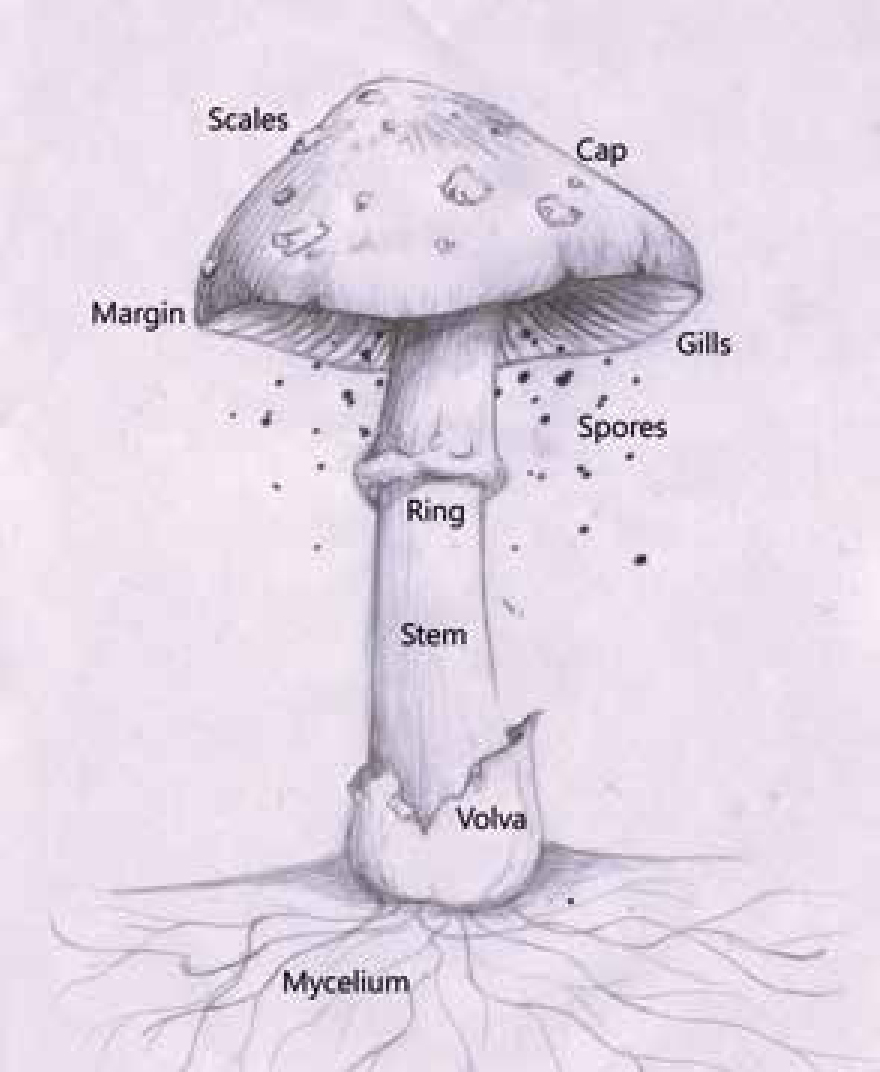
There are many cases of poisoning from mushroom ingestion in dogs but also in cats (Beug et al, 2006; Beug and Shaw, 2009; Tokarz et al, 2012; Herreria-Bustillo et al, 2013), cattle (Yee et al, 2012), sheep (Overås and Piqueras, 1979), horses (Hyde, 1990; Jones, 1990; Frazier et al, 2000), pigs (Galey et al, 1990) and a reptile (Fitzgerald and Newquist, 2008). Store-bought mushrooms are not hazardous to companion animals, but mushrooms that are poisonous to humans are also toxic to cats and dogs.
Identification
Identification of a particular fungus or fungal fragments is notoriously difficult, particularly if it has been chewed or broken. It may be possible to call on the expertise of a local mycologist, but attempting to match samples with photographs or drawings from books risk inaccuracies and misidentification. A poison centre may be able to help with identification and it should always be attempted since it may rule out ingestion of a toxic species, prevent unnecessary treatment and provide the owner with reassurance. Guidance on taking images and preparing samples for identification are given in Box 1.
If identification is impossible from a physical specimen, an alternative approach is to observe for the development of specific clinical signs. On the basis of the syndrome of clinical effects produced in humans, fungi can be grouped into several syndromes. If no signs develop, it may be that the animal ingested a non-toxic species (Figures 2 and 3) or perhaps did not eat any mushroom at all or insufficient quantity to cause clinical signs. Also, if more than one type of fungi has been ingested the clinical picture may fit more than one syndrome.
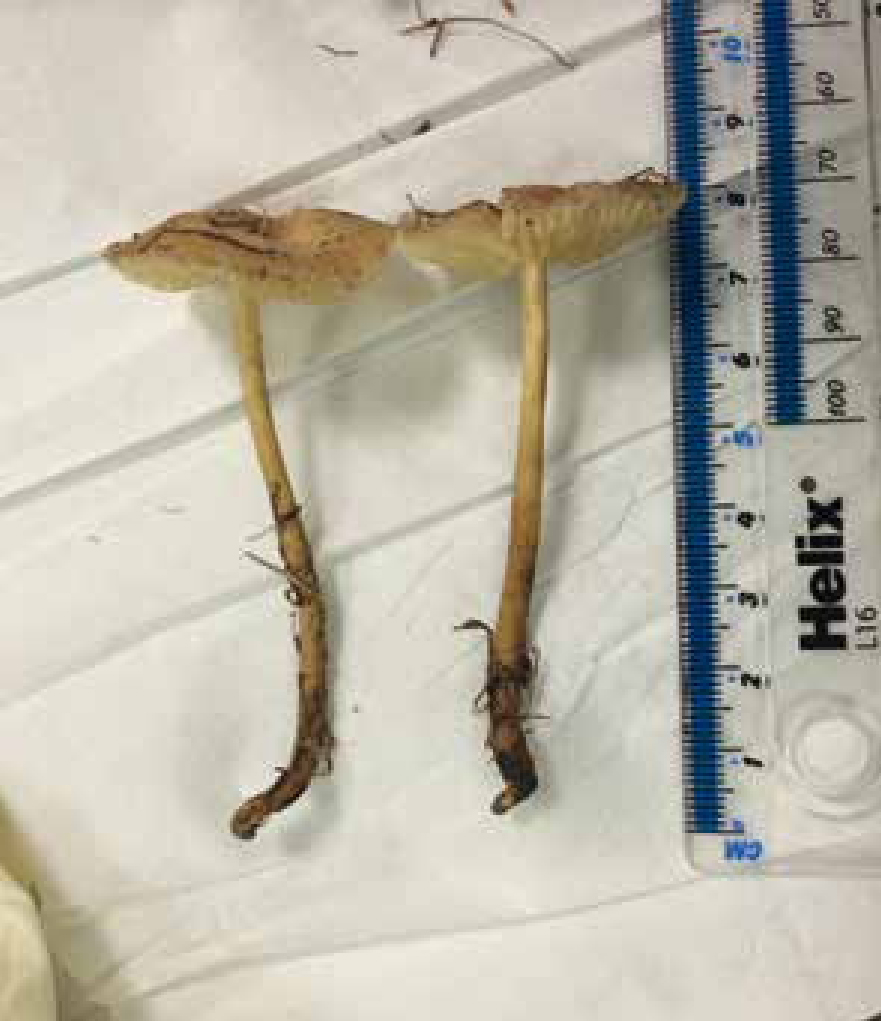
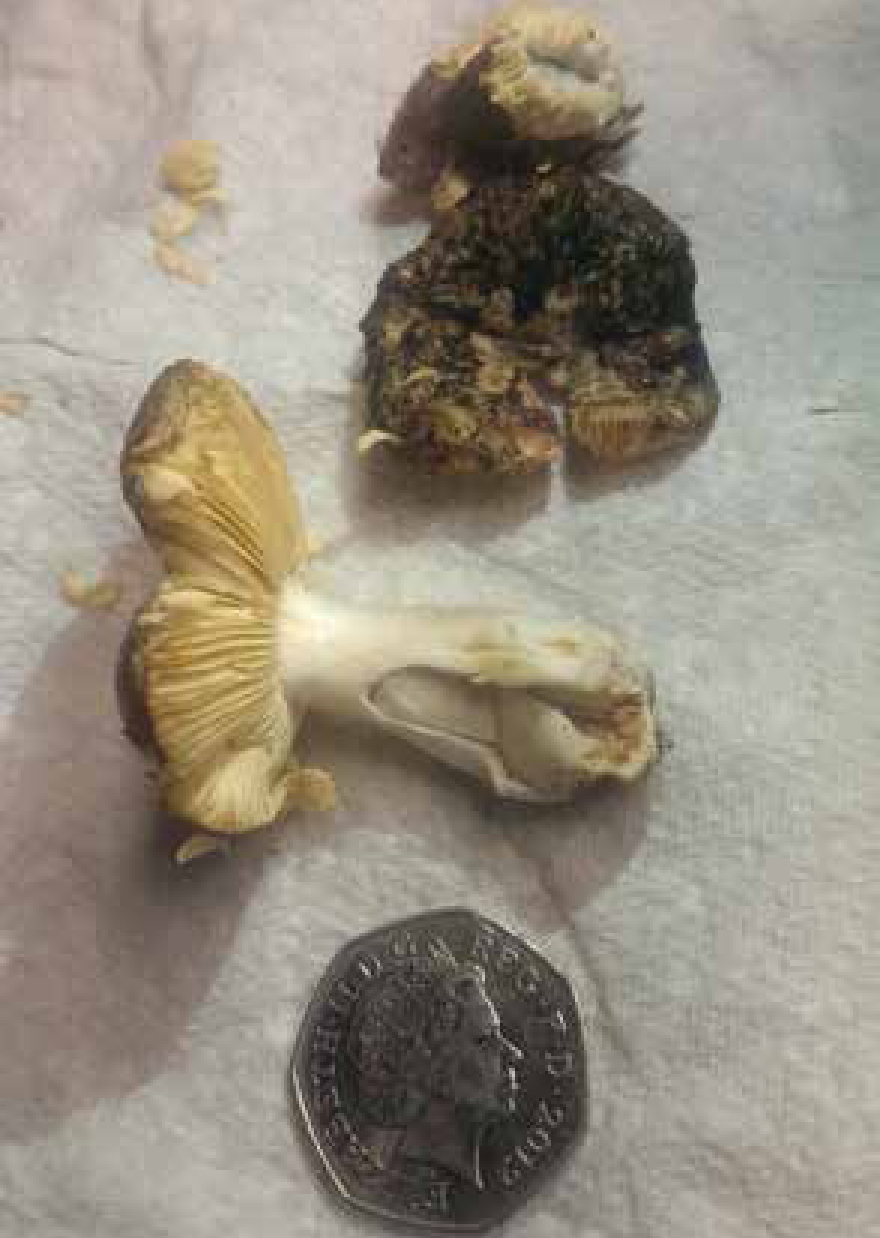
Gastrointestinal irritants
Numerous fungi can cause gastrointestinal signs, but the compounds causing these effects have not been identified. Some species in this group are considered edible, but even these in some individuals can cause gastrointestinal upset (Puschner and Wegenast, 2012). Some of the toxic compounds in these fungi are inactivated by cooking.
Clinical effects
Gastrointestinal effects usually within 15 minutes to 2 hours, occasionally up to 4 to 6 hours with recovery usually within 24 hours.
Signs include vomiting, diarrhoea, abdominal discomfort, malaise and weakness. Dehydration may occur if fluid loss is significant. Hypersalivation, lethargy, haematemesis and bloody stools may occur in some cases.
Treatment
Gastric decontamination is unlikely to be required after ingestion of a mushroom containing gastrointestinal irritants as vomiting is common. Treatment is symptomatic and supportive with rehydration and antiemetics as required. Gastroprotectants may be given if required.
Ibotenic acid
The most common mushrooms containing ibotenic acid and muscimol are Amanita pantherina and Amanita muscaria (Figure 4.)
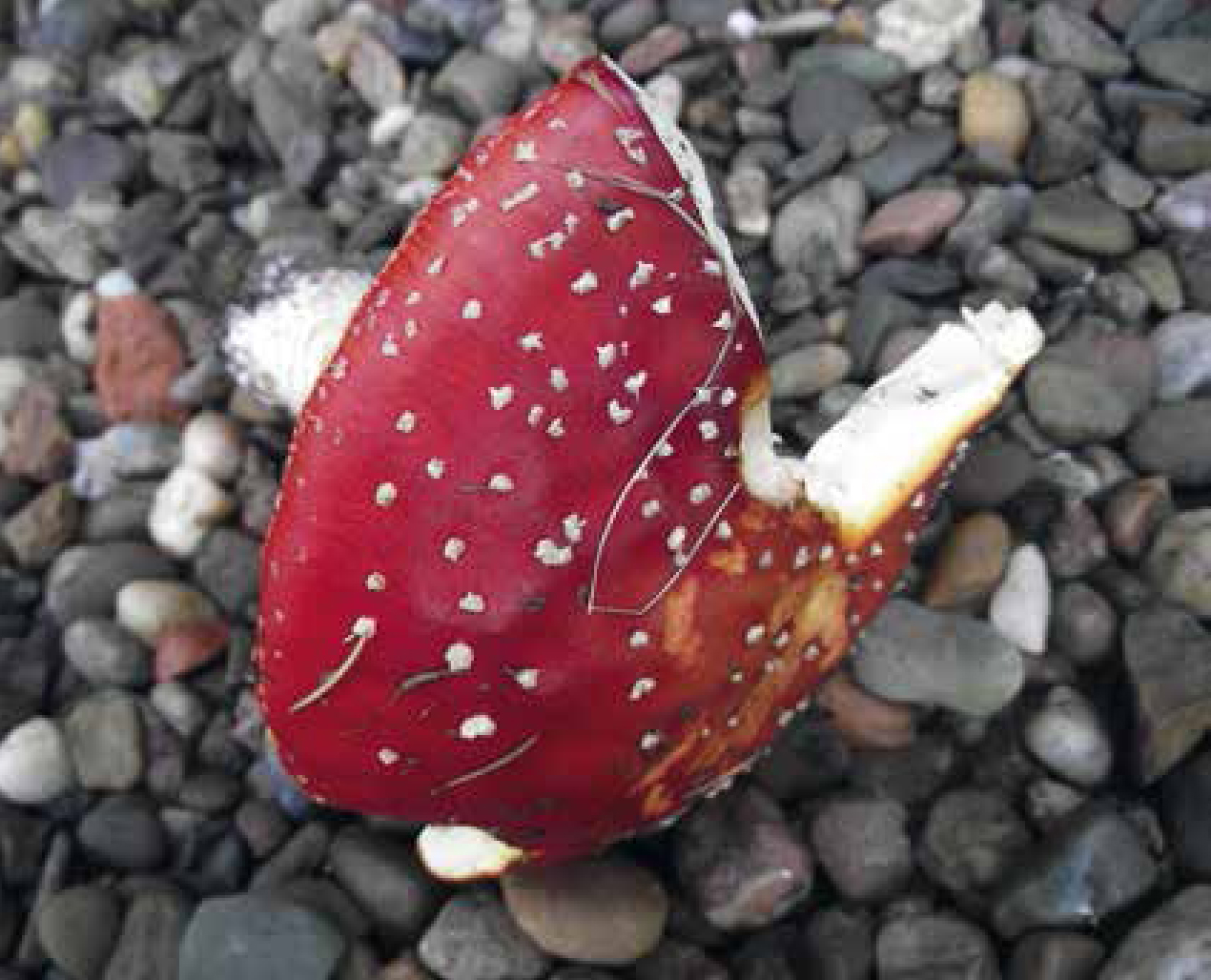
Ibotenic acid is converted to muscimol which is a structural analogue of the inhibitory neurotransmitter gamma-aminobutyric acid (GABA). Deaths have been reported in dogs and cats from ingestion of A. pantherina and A. muscaria, but this is rare. Most severe cases reported involve young or small animals (Hunt and Funk, 1977; Naude and Berry, 1997; Beug and Shaw, 2009; Beug, 2012; Lindberg and Holmgren, 2012). Some dogs have been euthanised while in a deep comatose state, but animals can recover even if they have severe signs (Beug and Shaw, 2009).
Clinical effects
Clinical signs of ibotenic acid poisoning occur within 30 to 120 minutes. Recovery can occur within 10–12 hours in some cases (Beug and Shaw, 2009), but can take 24–48 hours. The initial signs are due to ibotenic acid and last about 12–24 hours; this is followed by the effects of muscimol and last 24–48 hours (Rossmeisl et al, 2006).
The clinical picture in individual cases is variable; the signs involve gastrointestinal and neurological signs. Vomiting, confusion and disorientation, ataxia, hallucinations, dilated pupils, muscle spasms and cramps, paralysis and convulsions have been reported in humans. There are cycles of lethargy and agitation and hyperactivity (animals may be described as manic). Drowsiness is followed by a final phase of deep sleep or coma. There is risk of aspiration of vomitus. Hypersalivation can occur, but is not common (unlike with muscarine-containing mushrooms).
Treatment
Treatment is symptomatic and supportive. An emetic and activated charcoal should only be given in asymptomatic animals (Puschner and Wegenast, 2012). Animals should be kept in a calm, quiet and dark environment. It is important to note that some drugs are contraindicated in the management of ibotenic acid poisoning. Sedatives, including diazepam and barbiturates, should be avoided if possible as they may cause respiratory depression or arrest (Rossmeisl et al, 2006; Beug and Shaw, 2009). The agitation or hyperactivity phase can usually be managed without intervention. Ventilation may be required in animals with respiratory depression or arrest. It is important that poisoning from muscarine-containing mushrooms and ibotenic acid-containing mushroom should not be confused. Atropine can rapidly improve the signs of muscarine toxicosis, but exacerbate clinical effects of ibotenic acid poisoning (Beug and Shaw, 2009).
Muscarine
The most common muscarine-containing mushrooms are Inocybe (Figure 5) and Clitocybe species (Figure 6). These species sometimes have a fishy odour and some species of Clitocybe smell of aniseed; these odours may make them attractive to dogs (Reid, 1985). In one case a dog poisoned after ingestion of Clitocybe, recovered and returned to the site of the original incident and was poisoned again (Bates et al, 2014). Death has been reported in dogs after ingestion of Inocybe (Beug et al, 2006) and Clitocybe species (Irwin and Leech, 2014).
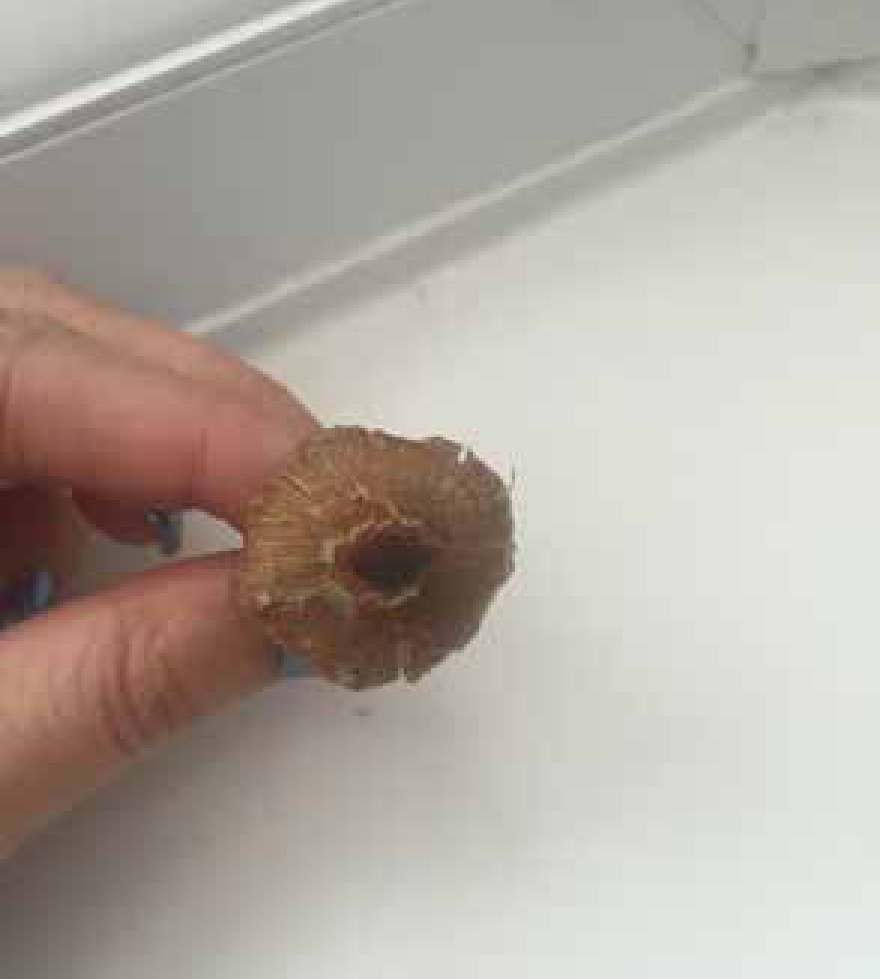
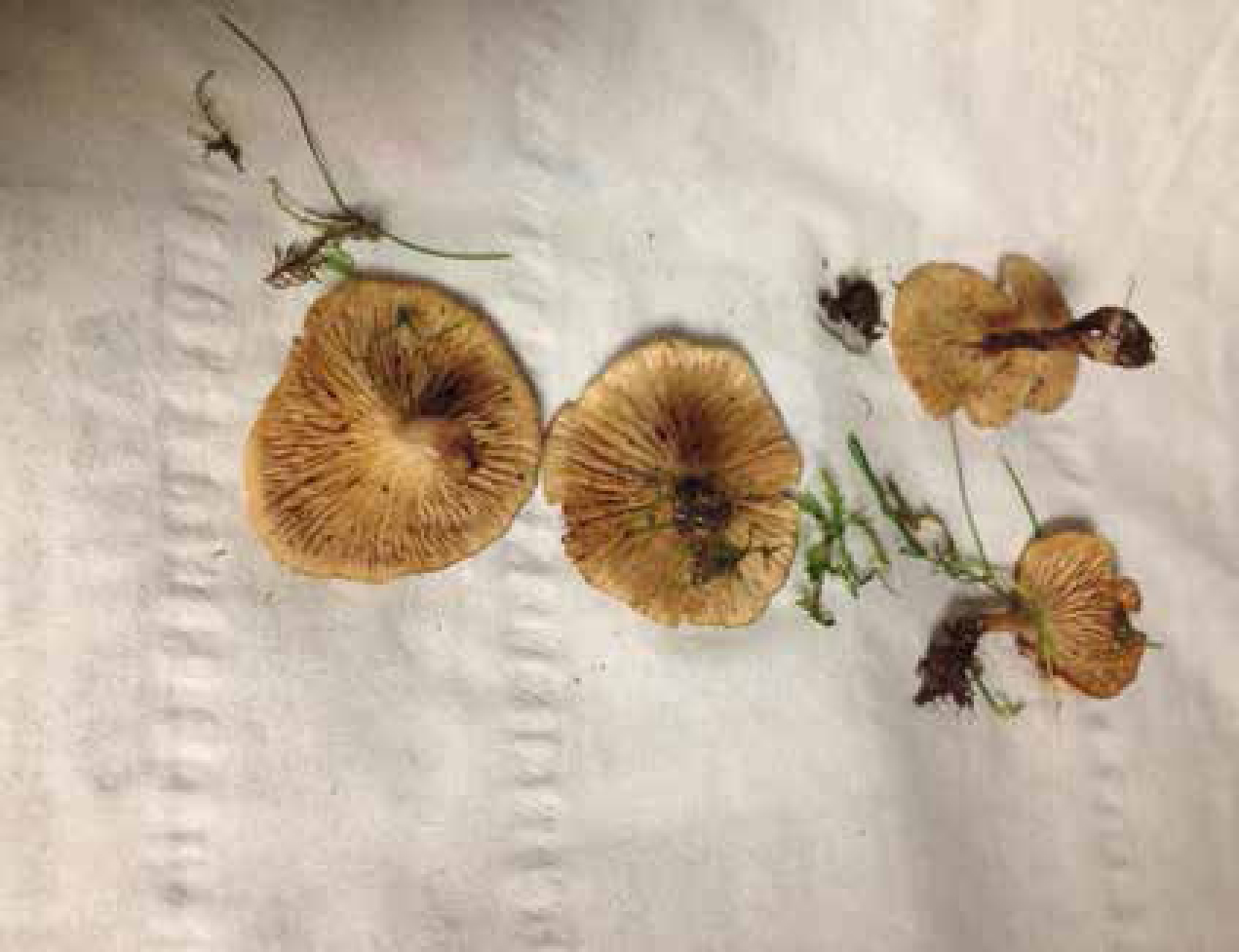
Muscarine is a potent parasympathomimetic compound structurally similar to acetylcholine and competes for some acetylcholine receptor sites. It is not metabolised by acetylcholinesterase so synaptic receptors are persistently stimulated.
Clinical effects
Signs of muscarine poisoning are very rapid (usually 15–30 minutes) and can be dramatic. Recovery is usually within 24 hours. Dogs are particularly susceptible to muscarine poisoning (NAMA, 2012).
Hypersalivation (with thick, ropey saliva), lacrimation, constricted pupils, visual disturbance, increased peristalsis and abdominal tenderness, vomiting, watery diarrhoea and urination can occur. In severe cases there can be collapse, bradycardia and hypotension. Dyspnoea can occur because of increased bronchial secretion and bronchoconstriction.
Treatment
The rapid onset of signs after muscarine poisoning often makes gut decontamination impractical (Puschner and Wegenast, 2012). If the animal is asymptomatic and has ingested fungi within the last 2 hours, emesis and activated charcoal (2 g/kg) can be considered. If there is severe or persistent vomiting then anti-emetics should be administered. Management is symptomatic and supportive, monitoring fluids and electrolytes. Intravenous (IV) fluids can be given for hypotension. In severe cases atropine may be required. Atropine competes for muscarine at receptors and signs should resolve within 30 minutes of administration. Care should be taken not to give too much atropine as this can result in tachycardia, hyperthermia, behavioural changes and gastrointestinal stasis (Puschner and Wegenast, 2012).
Psilocybin
The most common fungi containing psilocybin are Psilocybe (e.g. magic mushrooms).
Psilocybin is a tryptamine derivative structurally similar to LSD (lysergic acid diethylamine) although less potent (Aboul-Enein 1974).
Clinical effects
Onset of signs after ingestion of psilocybin-containing fungi is rapid (usually within 10 to 30 minutes, but can be up to 4 hours) and effects usually wear off within 6–12 hours, rarely as long as 24 hours.
Signs include dilated pupils, disorientation and uncharacteristic behaviour (anxiety, aggression, vocalisation, flysnapping), ataxia, tachycardia and hyperreflexia. Vomiting and nystagmus can occur. In severe cases, which are rare, there may be hypertension, hyperthermia and convulsions.
Treatment
Animals with mild signs of psilocybin poisoning can recover without treatment. If required activated charcoal can be given, if practical, but emesis is not advised as it may increase distress and anxiety. A calm, quiet environment is usually all that is required. In cases of severe distress (e.g. hallucinations), diazepam may be given (Benjamin, 1995). Acepromazine should be avoided as it may enhance anticholinergic effects.
Amatoxins
Several fungi contain cyclopetides, but the most common are Amanita species including Amanita phalloides (death cap), but not A. muscaria. There are three types of cyclopeptide compounds in hepatotoxic mushrooms; amatoxins, phallotoxins and virotoxins. Phallotoxins and virotoxins are of low oral toxicity, therefore the amatoxins are responsible for the clinical effects seen after ingestion of these mushrooms (Poppenga, 2009).
Fungi containing amatoxins are by far the most toxic and poisoning is characterised by hepatorenal failure. Amatoxins are primarily hepatotoxins and rapidly penetrate liver cells where they bind reversibly to RNA polymerase II, and completely inhibit the transcription of DNA into messenger RNA (mRNA) (Vetter, 1998). This prevents protein synthesis and results in cell death and tissue necrosis. Amatoxins undergo enterohepatic circulation, increasing exposure to the toxins (Busi et al, 1979). Amatoxins may cause changes in the renal tubular epithelium. Severe hypoglycaemia occurs due to break down of liver glycogen (Faulstich and Fauser, 1980).
One cap of A. phalloides can contain sufficient quantities of amatoxins to be lethal to a human, dog or cat (Puschner and Wegenast, 2012).
Clinical effects
The clinical picture of poisoning with amatoxin-containing fungi occurs in several phases. Initially there are no signs for 6–12 hours and this is followed by a gastrointestinal phase, starting from 6–24 hours and lasting 12–24 hours. There is lethargy with abdominal tenderness, vomiting, watery diarrhoea (may contain blood and mucus threads) with dehydration and collapse. Severe hypoglycaemia occurs.
This is followed by a second latent phase from around 24–48 hours and lasting 12–24 hours during which time liver enzymes rise and prothrombin time becomes prolonged. The terminal phase occurs from 48–96 hours postingestion with watery, bloody diarrhoea, jaundice, hepatic and renal failure, coagulopathy, encephalopathy, convulsions and coma. Death usually occurs within 5 to 16 days, but has been reported within 24 hours in dogs (Cole, 1993; Puschner et al, 2007).
In 21 laboratory-confirmed cases of amanitin-exposed dogs with known outcome 6 dogs recovered (28.5%) and 15 (71.5%) died or were euthanised (Poppenga, 2009). In human cases if early signs of renal failure are not corrected by fluid replacement the prognosis is poor (Faulstich and Zilker, 1994). Declining alanine aminotransferase (ALT) and aspartate aminotransferase (AST) concentrations indicate a more favourable prognosis (Liggett and Weiss, 1989).
Treatment
Management of amatoxin poisoning is symptomatic and supportive. The aim is to reduce absorption and enhance elimination of toxins with aggressive supportive therapy and antidotal treatment if possible.
Repeat-dose activated charcoal should be given for 24 hours after ingestion. Charcoal after 24 hours may be of limited benefit. In symptomatic cases the blood pressure, fluid balance, glucose, electrolytes, blood pH, renal and liver function and clotting parameters should be monitored.
Diarrhoea should not be treated as large amounts of amatoxins are excreted in the faeces (Jaeger et al., 1993). If vomiting is persistent anti-emetics may be given and animals should be aggressively rehydrated with IV fluids. Adequate hydration is important to maintain renal function. Human data suggest impaired renal function due to dehydration should respond to aggressive fluid replacement (Piqueras, 1989), but a large ingestion may result in direct renal toxicity (Constantino et al, 1978). Any electrolytes imbalances and hypoglycaemia should be corrected. Vitamin K or fresh frozen plasma should be given to correct clotting abnormalities. Blood transfusions may be required in dogs with severe clotting abnormalities or bleeding.
Several antidotes have been used for amatoxin poisoning (Table 1). Silibinin blocks uptake of amatoxins (Abenavoli et al, 2010), and in humans a 20-year review of amatoxin poisoning supported the use of silibinin alone or in combination with other antidotes (Enjabert et al, 2002). Acetylcysteine is an antioxidant and free radical scavenger and has been shown to have a positive effect in humans with amatoxin poisoning (Enjabert et al, 2002; Butera et al, 2004). It should be given in combination with silibinin. Benzylpenicillin (penicillin G) was used for many years in the treatment of amatoxin poisoning in humans, but is has been found to have little efficacy (Enjabert et al, 2002) and it is no longer recommended.
| Drug | Dosage in cats and dogs |
|---|---|
| Silibinin Also known as silybin, the major active constituent of silymarin, an extract of the milk thistle Silybum marianum | 250 mg/kg orally every 24 hours for 4–5 days. There are no clinical data on the optimal dose of silibinin in animals for the treatment of amatoxin poisoning. It has low oral availability (it is given intravenously (IV) in humans) and low toxicity so high doses are recommended. |
| Acetylcysteine | Same as for paracetamol poisoning. |
Orellanine
Several species of Cortinarius fungi contain orellanine, particularly Cortinarius rubellus (previously Cortinarius speciosisismus, deadly webcap) and C. orellanus.
Renal failure is characteristic of poisoning with some Cortinarius species. The toxins are orellanine and orelline. The mechanism of action it not fully understood (Michelot and Tebbett, 1990); they may inhibit protein synthesis in the renal tubular epithelium. The toxins may also cause free radical damage, lipid peroxidation and membrane destruction (Benjamin, 1995).
Clinical effects
Orellanine poisoning is rare in animals. Based on human data there is an initial latent phase that can last up to 17 days. This is followed by a pre-renal phase which usually occurs from 36 hours up to 17 days post-ingestion with an average duration of 7 days. The signs are mainly gastrointestinal and neurological with anorexia, vomiting, diarrhoea or constipation, shivering, polydipsia and polyuria, and myalgia. The earlier signs are experienced, the more severe the poisoning. There is then a renal phase (usually from 7 to 21 days post-ingestion) with kidney pain, oliguria or anuria, interstitial nephritis, proteinuria, haematuria and leucocyturia and chronic renal failure. Urinalysis may show isosthenuria, glucosuria, pyuria, proteinuria and haematuria.
Treatment
There is no specific treatment for ingestion of orellanine and care is symptomatic and supportive. If ingestion was recent an emetic and activated charcoal can be given. Renal function should be monitored and acute renal failure should be treated conventionally (Jaeger, 1994).
Gyromitrins
The most common mushroom involved in poisoning by gyromitrin is Gyromitra esculenta, but other species also contain these toxic compounds. In the stomach, gyromitrins are rapidly hydrolysed to N-methyl-N-formylhydrazine (MFH), some of which is then hydrolysed more slowly to the major toxin monomethylhydrazine (MMH). The mechanism of toxicity is not entirely clear. Monomethylhydrazine can bind to pyridoxine (vitamin B6) which is a co-factor in various enzyme systems and in amino acid metabolism. MMH is oxidised in the liver to unstable compounds which decompose to produce liver damage (Michelot and Toth, 1991).
Poisoning with these fungi is rarely reported in animals (Puschner and Wegenast, 2012), but in monkeys there was a narrow margin between a no effect level and a toxic dose of MMH (Back and Pinkerton, 1967). Death has occurred in dogs from ingestion of less than one Gyromitra esculenta cap (Bernard, 1979).
Clinical effects
Gyromitrin toxicity is characterised by gastrointestinal and hepatorenal signs. In the gastrointestinal phase (onset 2 to 24 hours after ingestion) there is abdominal tenderness, vomiting, diarrhoea, lethargy and pyrexia. The hepatorenal phase (onset 36 to 48 hours after ingestion) is characterised by hepatotoxicity and jaundice, tremor and muscle fasciculations, haemolysis, renal failure, severe convulsions, coma and respiratory arrest.
Treatment
Gastric lavage or an emetic can be considered if ingestion was recent, depending on the animal's clinical condition. Activated charcoal can be given, but treatment is symptomatic and supportive. The renal and liver function and blood sugar should be monitored. Convulsions should be treated conventionally with diazepam initially and phenobarbital if necessary.
Pyridoxine is the specific treatment for convulsions or coma in humans with gyromitrin poisoning, as it increases GABA concentrations, however, it does not protect against renal or hepatic effects. The dosage of pyridoxine in dogs is 75–150 mg/kg IV (Puschner and Wegenast, 2012), as a 5–10% solution in 5% dextrose over 30–60 minutes.
Puffballs
Puffball is a general term referring to a number of related fungi, including Lycoperdon species. They are called puffballs because a fine cloud of brown spores is released when the mature fruit body bursts. Note that some puffballs can resemble young Amanita species. All puffballs picked for ingestion should be cut in half lengthwise; young puffballs have undifferentiated white flesh, if there are gills it is not a puffball and may be a toxic species.
Puffballs are not toxic if ingested, but the spores can cause respiratory signs if inhaled. The spores are hydrophobic and may contain fungal allergens that can cause a hypersensitivity pneumonitis (or bronchoalveolar allergic syndrome) if inhaled.
Clinical effects
Puffballs are not toxic by ingestion but may cause a mild gastrointestinal upset.
Inhalation of puffball spores can cause respiratory signs. The onset is very variable; it may be short (within 4 to 6 hours) or can develop over several days. There is lethargy, cough, sneezing, dyspnoea, tachypnoea, hyperthermia and leucocytosis. There may be vomiting and inappetence. Recovery is also variable and can be relatively short (3 to 7 days) or take several weeks.
A chest x-ray may show bilateral infiltrates. Lung aspirates or biopsy show inflammatory changes and the presence of spores (Alenghat et al, 2009; Rubensohn, 2009; Buckeridge et al, 2011).
Treatment
Gut decontamination is not required following ingestion of a puffball. Supportive care is all that is required. If the spores have been inhaled treatment is supportive with corticosteroids (e.g. dexamethasone), antibiotics and oxygen if required.
What to do in cases of suspected mushroom poisoning
If an owner telephones about an animal with suspected ingestion of a mushroom, advise them to collect a specimen of the mushroom (see Box 1). This may be a fresh specimen or the fungal material in vomitus. A representative sample (Figure 7) should be collected, but note that more than one type of mushroom may be growing in the same area, so they may need to collect more than one mushroom. It is also important to note where the mushroom was growing as this can aid identification (see Box 1). If possible the owner should take images of the mushroom and where it was growing.
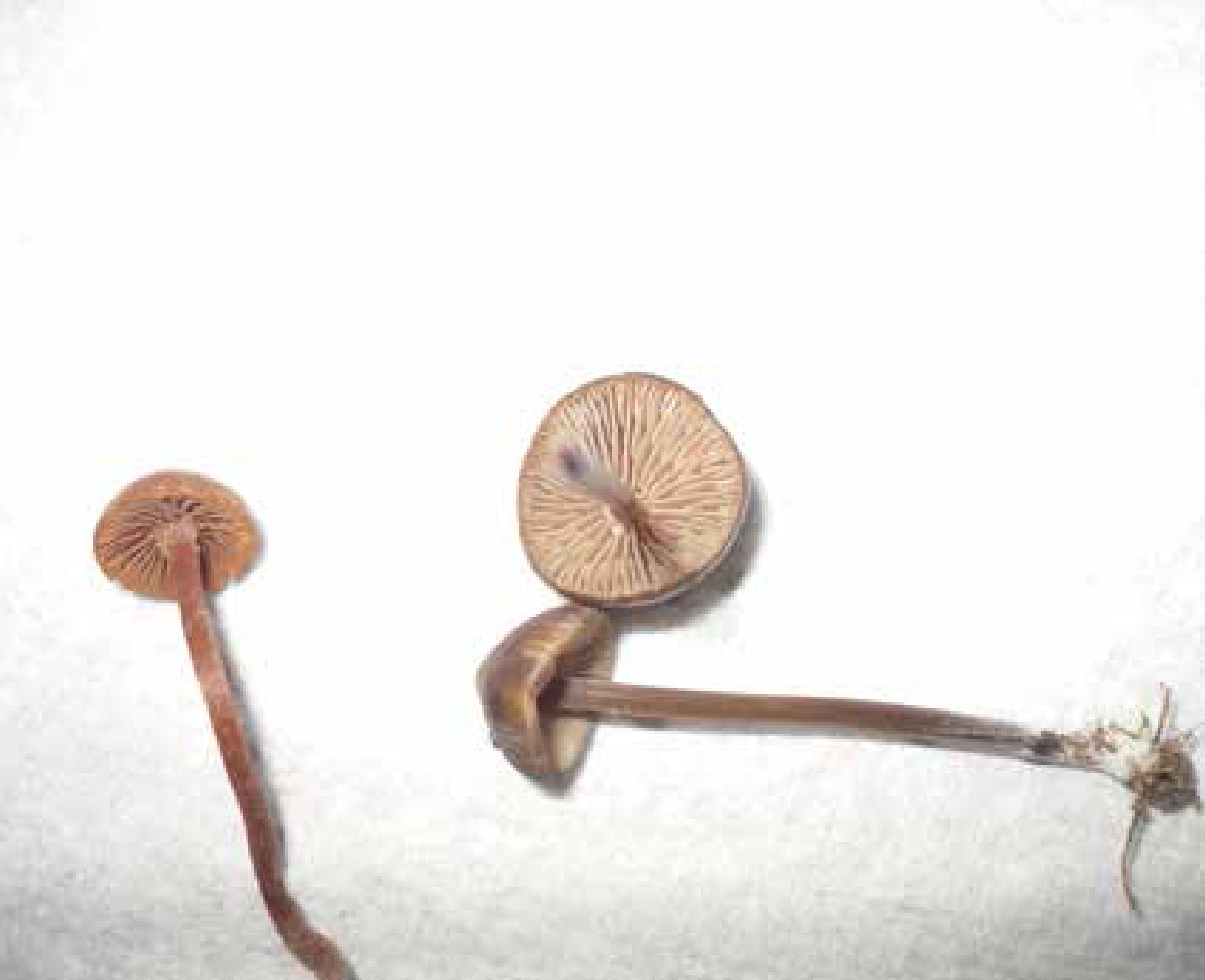
While waiting for identification or if no samples are available management should be supportive. Emesis and activated charcoal can be considered. Ensure adequate hydration with IV fluids and antiemetics if required. If signs are significant then the kidney and liver function should be monitored. Atropine should be used with care because although it can result in rapid improvement in clinical signs of poisoning with muscarine it should not be used in animals with ibotenic acid toxicosis. Similarly, diazepam and barbiturates should be avoided in the management of ibotenic acid poisoning since they may cause respiratory depression.
If the owner has brought in samples but no photographs, then using the guidelines in Box 1 take images of the mushroom(s). Contact a poisons information service or, if available, a local expert and send the images for identification. Even if the exact species cannot be identified it may be possible to rule out ingestion of a toxic mushroom and provide reassurance. If the mushroom is identified as one of the toxic mushrooms described, than manage as above.
Conclusion
In the majority of cases where fungi are eaten, no or only mild adverse effects occur as ingestion of toxic species seems rare. The most likely effects are early-onset vomiting and diarrhoea, which are generally self-limiting. Some species can cause hepatic and/or renal effects which may be fatal. Other fungal species may cause neurological signs. As a general rule of thumb delayed onset of clinical signs (more than 6 hours) suggests one of the more toxic species of fungi (e.g. containing orellanine, gyromitrin, amatoxins) whereas rapid onset of clinical signs (less than 6 hours) suggests that the animal has ingested one of the less toxic species (although signs may still be clinically significant). Identification should always be attempted to allow assessment of potential clinical signs and the provision of specific treatment or prevention of unnecessary treatment.

